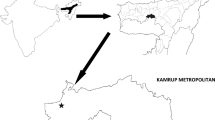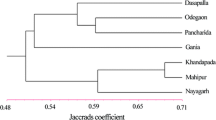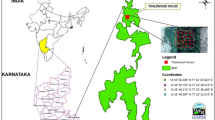Abstract
West Bengal forest department in India was a pioneer in initiating Joint Forest Management (JFM) at West Midnapore involving participatory forest management by both foresters and local communities in order to protect degraded forests. The research objective was qualitative and quantitative study of tree communities by quadrat method along with identification of major impacts of environmental factors affecting regeneration of five locations under JFM in natural coppicing Sal (Shorea robusta) dominated tropical dry deciduous forests of West Bengal. 23 families, 33 genera and 36 tree species were identified. Dominant families were Anacardiaceae and Combretaceae. There were statistically significant differences in stand diversity, dominance, richness and evenness. Generalized Linear Model predictors such as site categories, seasons, grazing intensity and invasive species frequency had significant impacts on seedling diversity, dominance, richness and density. Surface soil potassium and soil texture were best predictors of seedling abundance. Species with “poor”, “no” and “new” regeneration status necessitate proper attention in forest management plans involving regulation of exotic invasive species populations, grazing and browsing, lopping, fire, over-extraction of non-timber forest produce and prevention of illegal felling through vigilance and more active participation of Forest Protection Committees.

Source: Google Earth)
Similar content being viewed by others
References
Amazonas NT, Forrester DI, Silva CC, Almeida DRA, Rodrigues RR, Brancalion PHS (2018) High diversity mixed plantations of Eucalyptus and native trees: an interface between production and restoration for the tropics. For Ecol Manage 417:247–256. https://doi.org/10.1016/j.foreco.2018.03.015
Bhadouria R, Singh R, Srivastava P, Raghubanshi AS (2016) Understanding the ecology of tree-seedling growth in dry tropical environment: a management perspective. Energ Ecol Environ 1:296–309. https://doi.org/10.1007/s40974-016-0038-3
Botanical Survey of India (2016) http://www.bsienvis.nic.in/Database/Invasive_Alien_species_15896.aspx. Accessed 9 Oct 2016
Burnham KP, Anderson DR (2002) Model selection and multimodal inference. Springer-Verlag, New York
Ceccon E, Huante P, Rincón E (2006) Abiotic factors influencing tropical dry forests regeneration. Braz Arch Biol Technol 49:305–312
Clements FE (1904) The development and structure of vegetation. Bot Surv Nebr 7:1–175
Clements FE (1905) Research methods in ecology. The University publishing company, Lincoln
Clements FE (1907) Plant physiology and ecology. New York Henry Holt and company, New York, pp 202–214
De León Ibarra A, Mariano NA, Sorani V, Flores-Franco G, Rendón Alquicira E (2019) Physical environmental conditions determine ubiquitous spatial differentiation of standing plants and seedbanks in Neotropical riparian dry forests. PLOS One 14:e0212185. https://doi.org/10.1371/journal.pone.0212185
Dupuy JM, Chazdon RL (2006) Effects of vegetation cover on seedling and sapling dynamics in secondary tropical wetforests in Costa Rica. J Trop Ecol 22:65–76
Giardina C, Sanford JR, Dockersmith I (2000) Changes in soil phosphorus and nitrogen during slash burning of a dry tropical forest. Soil Sei Soc Am J 64:399–405
Good NF, Good RE (1972) Population dynamics of tree seedlings and saplings in a mature eastern hardwood forest. Bull Torrey Bot Club 99:172–178. https://doi.org/10.2307/2484571
Greig-Smith P (1983) Quantitative plant ecology, 3rd edn. Blackwell Scientific Publications, Oxford, England
Grellier S, Janeau JL, Barot S, Ward D (2012) Grass competition is more important than seed ingestion by livestock for Acacia recruitment in South Africa. Plant Ecol 213:899–908
Integrated Nutrient Management Division (2011) Methods manual: soil testing in India. Department of Agriculture and Co-operation, Ministry of Agriculture, Government of India, New Delhi, pp 89–96
Jackson ML (1958) Soil chemical analysis. Prentice-Hall, Inc., Englewood Cliffs, N.J., pp 115–119
Jhargram Monthly Climate Averages (2019) World weather online. https://www.worldweatheronline.com/jhargram-weather-averages/west-bengal/in.aspx. Accessed 21 Aug 2019
Johnson DJ, Condit R, Hubbell SP, Comita LS (2017) Abiotic niche partitioning and negative density dependence drive tree seedling survival in a tropical forest. Proc R Soc B 284:20172210. https://doi.org/10.1098/rspb.2017.2210
Khumbongmayum AD, Khan ML, Tripathi RS (2005) Ethnomedicinal plants in the sacred groves of Manipur. Indian J Tradit Knowl 4:21–32. http://nopr.niscair.res.in/bitstream/123456789/8490/1/IJTK4%281%2921-32.pdf
Knops JMH, Tilman DH, Naeem S, Mitchell C, Haarstad K, Ritchie M, Howe K, Reich P, Siemann E, Groth J (1999) Effects of plant species richness on invasion dynamics, disease outbreaks, insect abundance, and diversity. Ecol Lett 2:286–293
Kumar JIN, Kumar RN, Bhoi RK, Sajish PR (2010) Tree species diversity and soil nutrient status in three sites of tropical dry deciduous forest of western India. Trop Ecol 51:273–279
Malik ZA, Bhatt AB (2015) Phytosociological analysis of woody species in kedarnath wildlife sanctuary and its adjoining AReas in Western Himalaya, India. J For Environ Sci 31:149–163. https://doi.org/10.7747/JFES.2015.31.3.149
Malik A, Hussain A, Iqbal K, Bhatt AB (2014) Species richness and diversity along the disturbance gradient in kedarnath wildlife sanctuary and its adjoining areas in Garhwal Himalaya, India. Int J Curr Res 6:10918–10926
Menhinick EF (1964) A comparison of some species diversity indices applied to samples of field insects. Ecology 45:859–861
Mishra AK, Behera SK, Singh K, Mishra RM, Singh B (2013) Effect of abiotic factors on understory community structures in moist deciduous forests of northern India. For Sci Pract 15:261–273. https://doi.org/10.1007/s11632-013-0415-3
Murphy PG, Lugo AE (1986) Ecology of tropical dry forest. Annu Rev Ecol Syst 17:67–88
Murthy EN (2015) Ecology and phytosociology of the tropical dry deciduous forests of Kawal Wildlife Sanctuary, Telangana, India. J Threat Taxa 7:6972-6979. http://threatenedtaxa.org/index.php/JoTT/article/view/1894
Naeem S, Knops JMH, Tilman DH, Howe K, Kennedy T, Gale S (2000) Plant diversity increases resistance to invasion in the absence of covarying extrinsic factors. Oikos 91:97–108
Obiri JF (2011) Invasive plant species and their disaster-effects in dry tropical forests and rangelands of Kenya and Tanzania. J Disaster Risk Stud 3:417–428
Panda PC, Mahapatra AK, Acharya PK, Debeta AK (2013) Plant diversity in tropical deciduous forests of Eastern Ghats, India: a landscape level assessment. Int J Biodivers Conserv 5:625–639. https://doi.org/10.5897/IJBC2013.0581x
Pandey CB, Singh JS (1992) Influence of rainfall and grazing on belowground dynamics in a dry tropical savanna. Can J Bot 70:1885–1890
Pattnaik BK, Dutta S (1997) JFM in Bengal: a study in participatory development. Econ Polit Wkly 32:3225–3232. https://www.jstor.org/stable/4406180?seq=1#page_scan_tab_contents
Pielou EC (1966) The measurement of diversity in different types of biological collections. J Theoret Biol 13:131–144
Pound R, Clements FE (1898) A method of determining the abundance of secondary species. Reports of the survey and bulletin of the department: botanical series IV. Minn Bot Stud 2:19–24
Pound R, Clements FE (1900) Phytogeography of Nebraska. 2nd edn. Series: University of Nebraska. Botanical Survey of Nebraska. Lincoln, Neb. Published by the Seminar 1900. https://doi.org/10.5962/bhl.title.45969
Prain D (1903) Bengal Plants, vol I & II. Newman & Company, London
Raghubanshi AS, Tripathi A (2009) Effect of disturbance, habitat fragmentation and alien invasive plants on floral diversity in dry tropical forests of Vindhyan highland: a review. Trop Ecol 50:57–69
Raherison SM, Grouzis M (2005) Plant biomass, nutrient concentration and nutrient storage in a tropical dry forest in the south-west of Madagascar. Plant Ecol 180:33–45. https://doi.org/10.1007/s11258-005-8063-x
Rakotojaona H (2000) Écosystème forestier de la région d’Analabo (forêt de Mikea) sur sables roux foncés: Diversité, structure et dynamique de l’eau dans le sol. Université d’Antananarivo, Gerem, CNRE-IRD, Antananarivo
Ray Chaudhuri AB (2016) Forest management. Development Circle, Directorate of Forests, Government of West Bengal, India
Rodrigues PMS, Schaefer CEGR, Silva JDO, Júnior WGF, Santos RMD, Neri AV (2018) The influence of soil on vegetation structure and plant diversity in different tropical savannic and forest habitats. J Plant Ecol 11: 226–236. https://doi.org/10.1093/jpe/rtw135
Sahu SC, Dhal NK, Reddy CS, Pattanaik C, Brahmam M (2007) Phytosociological study of tropical dry deciduous forest of Boudh District, Orissa, India. Res J For 1:66–72. https://doi.org/10.3923/rjf.2007.66.72
Saikia P, Khan ML (2013) Population structure and regeneration status of Aquilaria malaccensis Lam. in homegardens of Upper Assam, northeast India. Trop Ecol 54:1–13
Santiago LS, Wright SK, Harms KE, Yavitt JB, Korine C, Garcia MN, Turner BL (2012) Tropical tree seedling growth responses to nitrogen, phosphorus and potassium addition. J Ecol 100:309–316. https://doi.org/10.1111/j.1365-2745.2011.01904.x
Shankar U (2001) A case of high tree diversity in a sal (Shorea robusta)-dominated lowland forest of Eastern Himalaya: floristic composition, regeneration and conservation. Curr Sci 81:776–786
Shannon CE, Weaver W (1963) The mathematical theory of communication. University of Illinois Press, Urbana, p 117
Sharma CM, Mishra AK, Prakash O, Dimri S, Baluni P (2014) Assessment of forest structure and woody plant regeneration on ridge tops at upper Bhagirathi basin in Garhwal Himalaya. Trop Plant Res 1:62–71
Simpson EH (1949) Measurement of diversity. Nature 163:688
Singh JS, Singh K (2011) Silviculture in the tropics. In: Günter S et al. (ed) Springer Berlin Heidelberg (Tropical Forestry), Berlin. https://doi.org/10.1007/978-3-642-19986-8
Singh S, Malik ZA, Sharma CM (2016) Tree species richness, diversity, and regeneration status in different oak (Quercus spp.) dominated forests of Garhwal Himalaya, India. J Asia Pac Biodivers 9:293–300. https://doi.org/10.1016/j.japb.2016.06.002
Soil Engineering Sectional Committee (1972) IS 2720-22: Methods of test for soils, Part 22: determination of organic matter. Bureau of Indian Standards, New Delhi
Soil Engineering Sectional Committee (1987) IS 2720-26: Methods of test for soils, Part 22: determination of pH value. Bureau of Indian Standards, New Delhi
Soil Survey Staff (1992) Soils of West Bengal for optimising land use. NBSS Publ. 27b (Soils of India Series 1). National Bureau of Soil Survey and Land Use Planning, Nagpur
Tripler CE, Kaushal SS, Likens GE, Walter MT (2006) Patterns in potassium dynamics in forest ecosystems. Ecol Lett 9:451–466. https://doi.org/10.1111/j.1461-0248.2006.00891.x
Wan B, Xu H, Ding H, Liu Z, Wang J (2007) Methodology of comprehensive biodiversity assessment. Biodivers Sci 15:97–106. https://doi.org/10.1360/biodiv.060132
Ward D, Esler KJ (2011) What are the effects of substrate and grass removal on recruitment of Acacia mellifera seedlings in a semiarid environment? Plant Ecol 212:245–250
Wu J, Lin W, Peng X, Liu W (2013) A review of forest resources and forest biodiversity evaluation system in China. Int J For Res 2013:1–7. https://doi.org/10.1155/2013/396345Article ID 396345
Yang X, Yan D, Liu C (2014) Natural regeneration of trees in three types of afforested stands in the Taihang Mountains, China. PLoS One 9:e108744. https://doi.org/10.1371/journal.pone.0108744
Acknowledgements
We convey thanks to the staff of Forest Department, Government of West Bengal and local villagers for their assistance and cooperation during field studies. We are also thankful to the faculty of Department of Environmental Science, Calcutta University for their support and guidance. We are grateful for the constructive comments received from two anonymous reviewers that enhanced the quality of the manuscript.
Funding
This research did not receive any specific grant from funding agencies in the public, commercial, or not-for-profit sectors.
Author information
Authors and Affiliations
Corresponding author
Ethics declarations
Conflict of interest
The authors declare no conflict of interest in the present study.
Rights and permissions
About this article
Cite this article
Gupta, B., Mishra, T.K. Analysis of tree diversity and factors affecting natural regeneration in fragmented dry deciduous forests of lateritic West Bengal. Trop Ecol 60, 405–414 (2019). https://doi.org/10.1007/s42965-019-00039-8
Received:
Revised:
Accepted:
Published:
Issue Date:
DOI: https://doi.org/10.1007/s42965-019-00039-8




